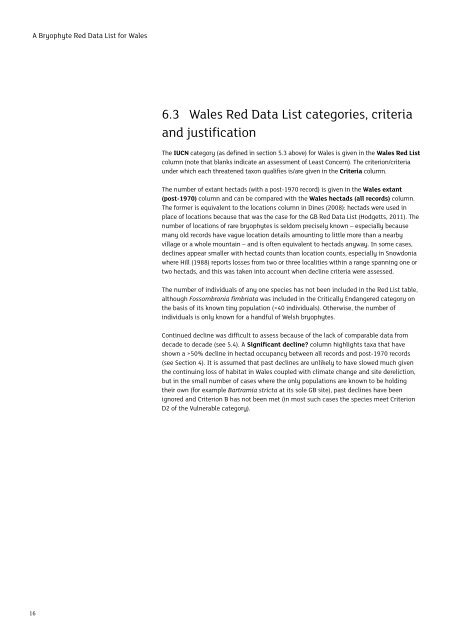Download this publication - Plantlife
Download this publication - Plantlife
Download this publication - Plantlife
You also want an ePaper? Increase the reach of your titles
YUMPU automatically turns print PDFs into web optimized ePapers that Google loves.
A Bryophyte Red Data List for Wales<br />
16<br />
6.3 Wales Red Data List categories, criteria<br />
and justification<br />
The IUCN category (as defined in section 5.3 above) for Wales is given in the Wales Red List<br />
column (note that blanks indicate an assessment of Least Concern). The criterion/criteria<br />
under which each threatened taxon qualifies is/are given in the Criteria column.<br />
The number of extant hectads (with a post-1970 record) is given in the Wales extant<br />
(post-1970) column and can be compared with the Wales hectads (all records) column.<br />
The former is equivalent to the locations column in Dines (2008): hectads were used in<br />
place of locations because that was the case for the GB Red Data List (Hodgetts, 2011). The<br />
number of locations of rare bryophytes is seldom precisely known – especially because<br />
many old records have vague location details amounting to little more than a nearby<br />
village or a whole mountain – and is often equivalent to hectads anyway. In some cases,<br />
declines appear smaller with hectad counts than location counts, especially in Snowdonia<br />
where Hill (1988) reports losses from two or three localities within a range spanning one or<br />
two hectads, and <strong>this</strong> was taken into account when decline criteria were assessed.<br />
The number of individuals of any one species has not been included in the Red List table,<br />
although Fossombronia fimbriata was included in the Critically Endangered category on<br />
the basis of its known tiny population (50% decline in hectad occupancy between all records and post-1970 records<br />
(see Section 4). It is assumed that past declines are unlikely to have slowed much given<br />
the continuing loss of habitat in Wales coupled with climate change and site dereliction,<br />
but in the small number of cases where the only populations are known to be holding<br />
their own (for example Bartramia stricta at its sole GB site), past declines have been<br />
ignored and Criterion B has not been met (in most such cases the species meet Criterion<br />
D2 of the Vulnerable category).

















